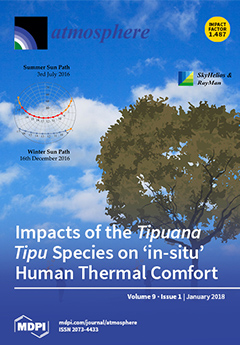Reference evapotranspiration (
ET0) is a crucial parameter for hydrological modeling, land-atmospheric interaction investigations and agricultural irrigation management. This study investigated changes in
ET0 and attributed those changes to climate variations in a coastal area (Zhejiang province) of China by
[...] Read more.
Reference evapotranspiration (
ET0) is a crucial parameter for hydrological modeling, land-atmospheric interaction investigations and agricultural irrigation management. This study investigated changes in
ET0 and attributed those changes to climate variations in a coastal area (Zhejiang province) of China by a numerical experiment method. The results indicated that annual
ET0 increased significantly (
p < 0.05) at a rate of 1.58 mm·year
−1 from 1973 to 2013, which was mainly caused by an obvious increase in
ET0 in spring. Air temperature and water vapor pressure deficits increased significantly (
p < 0.05) at rates of 0.04 °C·year
−1 and 0.005 kPa·year
−1, respectively, at an annual time scale during the study period, while wind speed and solar radiation decreased significantly (
p < 0.05) at rates of −0.01 m/s·year
−1 and −3.94 MJ·m
−2·day
−1·year
−1, respectively. The contributions of changes in air temperature, wind speed, water vapor pressure deficits and solar radiation to increases in
ET0 were 0.39, −0.56, 2.62 and −0.61 mm·year
−1, respectively. The decrease in wind speed and solar radiation negatively affected the increase in
ET0, which was offset by the positive effects of the air temperature and water vapor pressure deficits increase, where the water vapor pressure deficits was the dominant factor in increasing
ET0 in the coastal area. Moreover, the impact of topography on
ET0 was further discussed.
ET0 changes at plain stations were approximately 5.4 times those at hill stations, which may be due to the impact of a large water body and the augment of surface roughness from intense human activities in the well-developed plain area. The results are helpful for investigating spatial and temporal changes in the evaporative demand for well-developed regions under energy-limited conditions.
Full article





